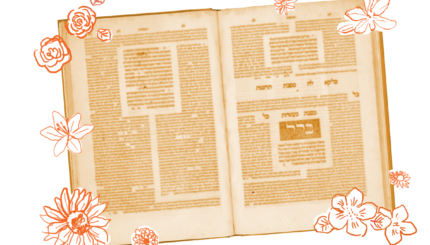“Not trying to be a prophet
but he who parted the sea,
is a part of me
and when I look in my heart I see
the same mystery.”These opening lines of a song by Matt Bar, a contemporary Jewish rapper, describe his inspiration to dip into the waters of Jewish tradition, and interpret it through hip hop and folk rap. Like many contemporary Jewish artists, writers, and musicians, Bar sees himself as part of an unbroken chain of Jewish textual interpretation, and he views his enterprise as modern midrash.
Many have been tempted to label all works of art inspired by traditional themes or biblical characters as midrash. While appreciating these diverse works of Jewish art, from Agnon‘s written words to Chagall‘s painted scenes, perhaps we can sketch a more circumscribed set of boundaries for the rabbinic genre of midrash and its modern counterpart.
Traditional midrash, written and compiled between the first and 11th centuries, are commentaries on the books of the Bible which often focus on specific words, verses, or chapters. In these works, which include Genesis Rabbah and Midrash Tehillim, a darshan, or interpreter, looks for unusual words, curious plot twists, or contradictions and uses these textual anomalies as a window for interpretation or re-imagination of the back-story to the brief biblical tales.
While Bar’s hip-hop beats are new to Torah study, many of his songs maintain the rabbinic method of close reading and a love of word play. For example, in Bar’s rap Exodus 5, he responds to an odd plot twist: The Israelite elders seem convinced that redemption is near at the end of Exodus 4, but in the next chapter Pharaoh’s decree for increased labor instantly crushes all their hope. Why this sudden loss of faith?
Bar fills in the gaps, putting these words into Pharaoh’s mouth: “Listen to me Moses because I know that you know my name…I don’t even know His name, I know you know my name.”
In Bar’s version of the story, Pharaoh claims tangible power, and points out that the Israelite God is invisible and doesn’t have a reputation or a name. To explain the elder’s wavering faith, Bar evokes an earlier conversation between Moses and God, in which Moses persuades God to reveal His name as a means of assuaging the doubts of the people (Exodus 3:13-15). Like many midrashim, this rap answers a local question by connecting the dots between various parts of the biblical narrative.
Bar’s Bible Raps Project is also similar to traditional midrash insofar as both are polyphonic–bringing together many diverse voices. Traditional midrash includes many opinions on a single verse often in dialogue or disagreement. Bar and his creative director Ori Salzberg (brother of this author) also endeavor to make their concept democratic, by running workshops in camps and schools that encourage kids to write their own musical midrash and add their voices to the mix.
Feminism in Rabbinic Cadence
Adhering more closely to the rabbinic midrash format is a new book called Dirshuni: Israeli Women Writing Midrash (2009) edited by Tamar Biala and Nechama Weingarten. Written in Hebrew, by a diverse cross-section of modern Israeli women, the book maintains the cadence and collectivist nature of traditional midrash, while adding a feminist twist.
Beyond re-imagining biblical texts, Dirshuni provides a midrash on rabbinic literature, playing with the Aramaic and updating its patriarchal perspectives. Here is an example, again, from Exodus.
After Pharaoh decrees that all Jewish boys be thrown into the Nile, the Bible details the midwives’ rebellion: “They did not do as the King of Egypt decreed, but saved the boys, alive” (Exodus 1:17). The classical midrash in Exodus Rabbah explains that the apparently superfluous words “saved the boys, alive” communicate double praise: Not only did the midwives not kill the babies, but they brought water and food to the Jewish slave women to ensure the child’s continued survival.
While the classical midrash does speak in praise of women, still women are lauded only for fulfilling the feminine role of caregiver to mothers and babies. But in Dirshuni, Rivkah Lubitch a rabbinic advocate and feminist writer, interprets the same passage in Exodus, suggesting that the midwives were spiritual and intellectual leaders; the words “saved them, alive” signal that the midwives gave life by teaching Torah during their home visits. Lubitch echoes the famous rabbinic proverb, “There is no life without Torah,” but instead of referring to the traditional image of male rabbis who made Torah study their life, she applies it to women taking an active role in inspiring the nation.
Editor Tamar Biala envisions this book on the shelves of the Beit Midrash, alongside the classical canon: “These modern interpretations embody the revelations of diverse women, whose voices have been lacking for millennia.”
Dramatic Interpretation
Storahtelling, a dynamic improvisational drama group based in New York City, suggests that modern midrash is not limited to text. Founded in 1999 by Amichai Lau Lavie, Storahtelling ties experiential learning to interpretation of the Torah. Many Storahtelling performances take place in synagogues, around the bimah where the weekly Torah portion is chanted.
Modeled after the traditional maven, an interpreter who provided a simultaneous translation of the Bible in ancient synagogues, facilitators interrupt the reading to translate and dramatize the biblical narrative. While the traditional maven was charged to give a translation that didn’t deviate greatly from the text, he was often influenced by midrashic interpretations.
During the reading of Parashat B’Shalah, which tells the story of the Israelites leaving Egypt, Storahtelling performers act out a scene in which a male character, reminiscent of Woody Allen, argues with his wife about whether to risk following Moses. Their contemporary portrayal of cynicism and doubt is reminiscent of a traditional midrash about some Israelites who chose not to leave Egypt (Exodus Rabbah 14:3). In the Storahtelling version, the facilitator personalizes the learning further, by asking the audience whether they are brave enough to take the first plunge into the sea–into the unknown in their own lives.
The Storahtelling logo articulates the characteristics of modern midrash. By equating ancient, new, and sacred this image represents the bridging of the traditional canon and the Jewish present. The ancient text does not disappear behind the concerns of modernity; rather the original words, imbued with ever-changing interpretations, propel Jewish artistic expression. This reciprocity sustains the spiritual relevance and sacred nature of the biblical text as it is revisited through midrashic dialogue.
The eye in the center may represent the collectivist voice of ancient and new midrash, which constantly demands the vision and revision of the darshan. Perhaps the biggest change to classical midrash is the widening of this voice to include musicians, feminists, actors and any lay person who wishes to join their ranks.
Rivkah
Pronounced: RIV-kuh, Origin: Hebrew, the biblical character Rebecca.
Torah
Pronunced: TORE-uh, Origin: Hebrew, the Five Books of Moses.



